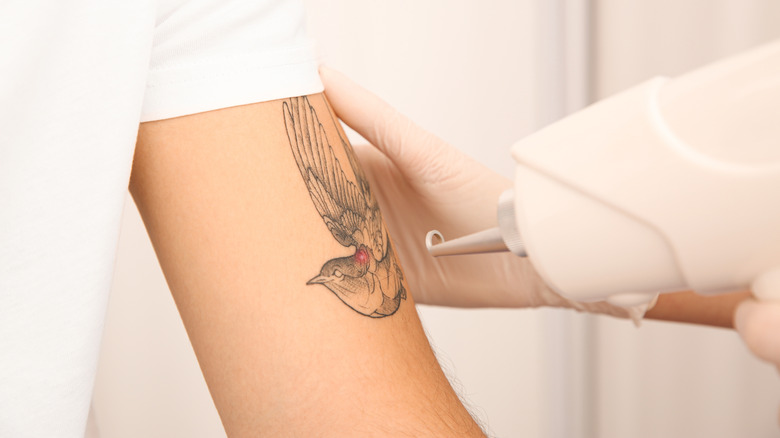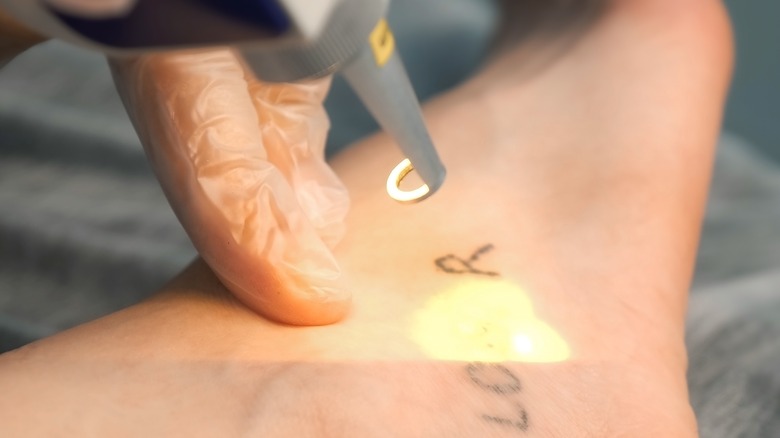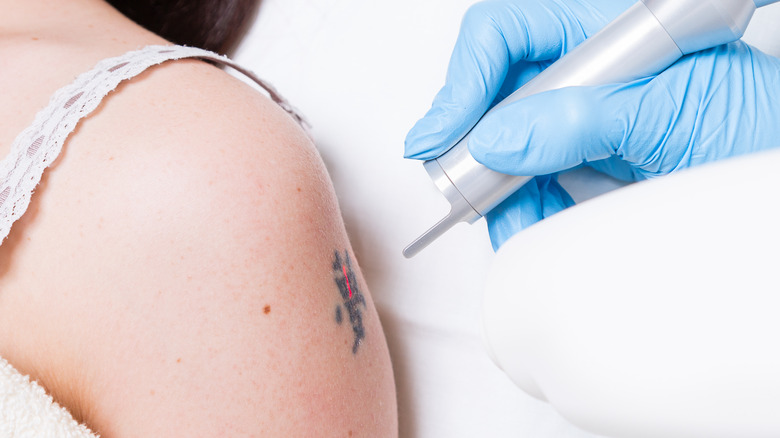Why You Should Think Twice Before Trying At-Home Tattoo Removal
Regret can come in different forms. Sometimes you regret saying something to someone you love. Other times you regret that you didn't delete that particular dating app sooner, sparing yourself some major heartbreak, while other times you regret the tattoo of a dolphin smoking a hookah you got at 18 and assumed you'd love forever. Regretting a tattoo happens.
According to a survey by Advanced Dermatology, 78% of those with tattoos regret at least one of them. And of those regrettable tattoos, 63% are no bigger than the size of one's palm. But while regret tends to be one of the big reasons why someone might want to get a tattoo removed, it's certainly not the only reason. For some, it's because the tattoo lost meaning or didn't age well, for instance (via Clean Slate Laser Clinic).
For others, like Pete Davidson, it's a matter of work. "I didn't think that they would put me in stuff," Pete Davidson told Seth Meyers on "Late Night with Seth Meyers" in May 2021 (via YouTube). "I thought after SNL it was a wrap. I honestly never thought that I would get an opportunity to act and I love it a lot." Not only did Davidson tell Meyers about the lengthy process of having his tattoos covered for film roles, but now that he's having them removed, the horrific pain that comes with the territory. "Not only are they like burning off your skin, you're wearing these big goggles so you can't see anything," Davidson explained. Basically, it's a pretty intense procedure and one that shouldn't be done at home. However, that doesn't stop people from trying.
How DIY tattoo removal kits work
Tattoos aren't supposed to be removable. After all, they're supposed to be permanent. In fact, although the Food & Drug Administration has approved several laser devices to remove tattoos, there's still no guarantee you'll get the results you want with them. "Complete removal, with no scarring, is sometimes not possible," says the FDA's Mehmet Kosoglu, Ph.D., whose job is to review and then clear these laser devices for tattoo removal. Even if you sit through sessions upon sessions, it doesn't mean that the tattoo you've been regretting for the past several years will leave no trace behind. You see, that's the problem with something that's meant to be permanent.
What DIY tattoo removal kits boast in addition to being cheaper than going to a clinic is that they're fast and effective. But the reality is that these kits, which often contain a laser pen of their own, not only don't work in removal because of their wavelength, they do work when it comes to doing severe damage like causing blistering, as well as life-long scarring and pigmentation issues (via Removery). Sure, you hate your tattoo, but you can love a wonky-colored scar? The irony is that one product in particular — Neatcell — claims that it removes scars, too. However, scars can't be removed. While they can become less visible in time, the very definition of the word "scar," per Merriam-Webster, is "a mark remaining (as on the skin) after injured tissue has healed."
Why you should think twice about a DIY tattoo removal kit
It should go without saying that anything that has the label "DIY" should be taken with a grain of sand. Of course, if it's along the lines of making your own centerpieces for your wedding or DIY candles shaped like Venus de Milo, then there's not too much of a risk there. The risk comes in when you're dealing with your health, as well as your ability to do something that professionals get paid to do. If you wouldn't give yourself a tattoo, then you probably shouldn't remove your own tattoo.
Although a DIY tattoo removal kit can seem appealing because it saves money and time, those still aren't good enough reasons to take such a risk. According to the American Society of Plastic Surgeons, the average cost of tattoo removal is $423 per session, and it also takes more than one session to have a tattoo removed. "A complete tattoo removal takes a minimum of two and a half years on average," tattoo removal specialist Bethany Cirlin tells Glamour. "Laser treatments should be scheduled three months apart from one another so you get the most out of each treatment. This allows your body to break down as much of the tattoo as it can while also giving your body the opportunity to heal completely before your next session."
While no one can fault you for wanting the cheaper and quicker way out of your tattoo, the fact remains that it's worth the money and worth the time to do it right. You don't want to remove one regrettable mistake just to replace it with another one.


